12 Types of Companion Plants for Blackberries (With Pictures)
-
Pete Ortiz
- Last updated:

If you want to grow healthy and high-yielding blackberry bushes, consider adding companion plants to the garden area. Companion planting is a traditional method many organic gardeners use to yield healthy crops. It involves grouping plants with similar growing requirements together to enhance the production and health of each plant.
If you’re looking for companion plants for blackberries to use in your gardening project, this guide is for you! Here are 12 companion plants that will help your blackberry bushes flourish. We’ll also look at several plants you should never plant with blackberries.
The Top 12 Types of Companion Plants for Blackberries
1. Strawberries
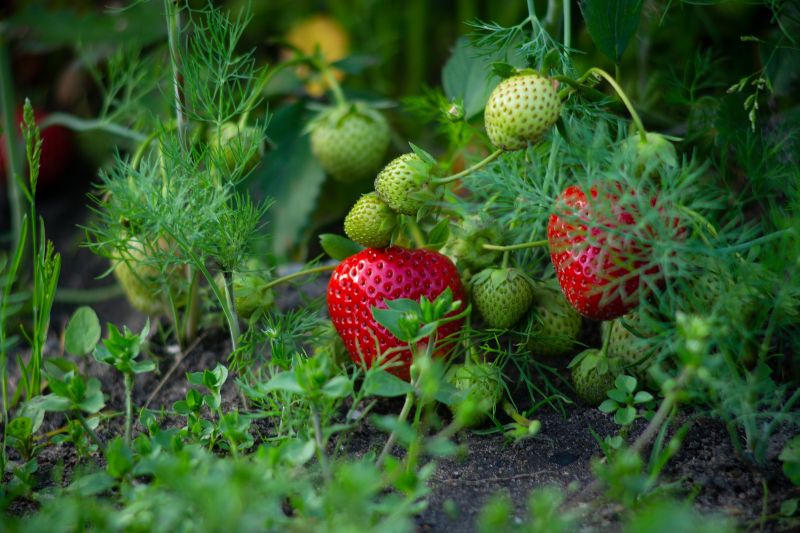
| Best Soil Type: | Sandy loam soil with high organic matter |
| Soil pH: | 5.8 to 6.2 |
| Sunlight Exposure: | Not less than six hours of direct sunlight per day |
| Watering Requirements: | One or two inches of rain or watering every week |
| Optimum Growing Temperature: | 50°F to 80°F (10°C to 26.7°C) |
Both strawberries1 and blackberries are perennial plants native to temperate regions worldwide. The two make an excellent combination. The strawberries will reduce weed growth as they’re excellent ground cover. They also reduce moisture loss and erosion of the topsoil.
These two plants will shed their leaves as winter approaches, adding organic matter to the soil that will benefit both plants to grow and sprout new leaves at the end of winter.
Plant the blackberry bushes four feet apart from each other and the strawberries to give the bushes plenty of room for their roots and allow easy harvesting later on.
2. Blueberries

| Best Soil Type: | Acidic soil |
| Soil pH: | Between 4.5 and 4.8 |
| Sunlight Exposure: | Full sun |
| Watering Requirements: | One inch of water every week |
| Optimum Growing Temperature: | 65°F to 85°F (18°C to 29°C) |
Blueberries are native to North America1, but they grow worldwide. You can train them to grow into a hedge or as tall bushes. They are one of the best companion plants for blackberry bushes as they attract beneficial insects that help keep pests under control. Blueberries1 also provide shade that protects the roots of your blackberry bushes from extreme temperatures.
These two grow together well as they don’t use the same nutrients, thus no competition for the same nutrients. The two plants also attract pollinators. You can enhance pollination rates by growing these two plants together.
3. Grapes

| Best Soil Type: | Loamy soil |
| Soil pH: | Between 5.5 and 8.5 |
| Sunlight Exposure: | Full sun |
| Watering Requirements: | ½ to one inch of water every week |
| Optimum Growing Temperature: | Between 77°F and 90°F (25°C to 32°C) |
Grapes have been cultivated for thousands of years. Blackberries are closely related to grapes, as they have similar cultural requirements. They grow well together in a garden bed.
Blackberries enjoy growing beside grapes, but the grapes1 will benefit more from blackberries. They help loosen the soil, making it easy for the grape roots to penetrate and spread out. Since both plants are climbers, ensure one of them grows up a trellis so that they won’t get tangled in each other.
4. Sunflower

| Best Soil Type: | It can grow in many soil types |
| Soil pH: | A bit acidic and a bit alkaline (Between 6.0 and 7.5) |
| Sunlight Exposure: | Full sun |
| Watering Requirements: | An inch of watering per week to maturity |
| Optimum Growing Temperature: | Between 70°F and 78°F (21°C to 25.5°C) |
Sunflowers are a great companion plant for blackberries, but only if you have room in your garden for both plants. The two plants don’t compete for the same nutrients.
The sunflower’s1 tall stalks can provide a visual barrier between your garden and the rest of the neighborhood. This way, animals like deer, rabbits, birds, and squirrels won’t attack your blackberries. Sunflowers also produce large amounts of nectar during the summer thus attracting pollinators such as bees. The flowers are also attractive to butterflies, which will also help pollinate your blackberries.
Remember that sunflowers need full sun, so plant them where they’ll be exposed to sunlight for more than six hours daily.
5. Tansy

| Best Soil Type: | Fertile and well-drained soil |
| Soil pH: | 5.0 to 7.5 |
| Sunlight Exposure: | Full sun to light shade |
| Watering Requirements: | Water only during prolonged dry periods |
| Optimum Growing Temperature: | Between 40°F and 70°F (4.4°C to 21°C) |
Tansy is an herbaceous perennial with yellow flowers. This plant changes the nitrogen in the soil to a more helpful form that other plants such as blackberries can use to thrive. Blackberries will have an increased flower production as there’s enough nitrogen in the soil. The smell of tansy also deters insects including aphids and Japanese beetles from eating your berries.
Tansy1 is easy to grow from seed in early spring or late fall. You can grow both plants in the same bed to maximize their benefits. However, keep kids and pets away from tansy because it’s poisonous.
6. Borage

| Best Soil Type: | Well-draining, slightly moist soil |
| Soil pH: | 6.0 to 7.0 |
| Sunlight Exposure: | Full sun or partial shade |
| Watering Requirements: | Water during the dry spell. Ensure the soil remains moist |
| Optimum Growing Temperature: | A minimum of 50°F (10°C) |
Borage (also called a starflower) is a pretty plant that attracts beneficial insects to a garden. It provides an excellent source of nectar and pollen for bees. The bees pollinate blackberry flowers, and this means more yield for your blackberry plants.
Borage1 also helps improve the health of the soil. It leads to more and better-tasting fruit. You can plant borage directly in the ground around your blackberry plants, or you can plant them in pots and place them around your garden.
7. Bee Balm
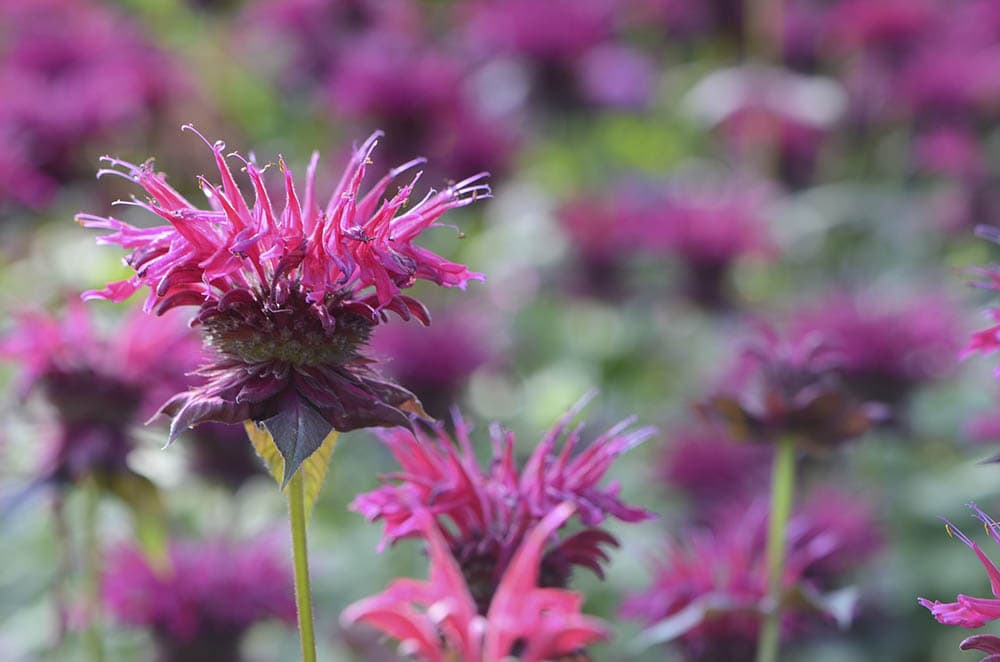
| Best Soil Type: | Uniformly moist soil with high organic matter |
| Soil pH: | 6.0 to 6.7 |
| Sunlight Exposure: | At least six hours of full sun |
| Watering Requirements: | After seven or ten days, when dry |
| Optimum Growing Temperature: | Higher than 70°F (21°C) |
Bee balm1 is a perennial that flowers from June to July. It has a low spreading habit and will grow two to four feet tall. Though often used as an ornamental plant, it’s an excellent blackberry companion plant.
As the name suggests, bee balms attract bees to pollinate blackberries. A few clumps of bee balm around your blackberry patch will provide plenty of nectar for honeybees and other pollinators. It also has a deep root system that helps break up the soil. This way, it improves drainage and prevents erosion.
8. Hyssop
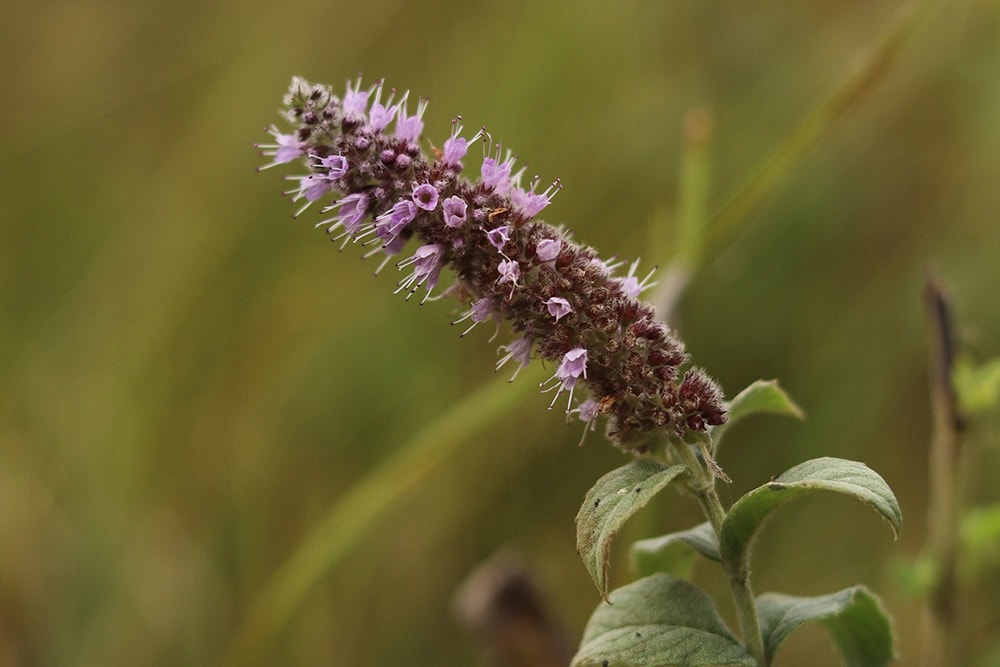
| Best Soil Type: | Well-draining, fertile loam soil |
| Soil pH: | 6.6 to 8.5 |
| Sunlight Exposure: | Full sun to partial shade |
| Watering Requirements: | Water consistently until established |
| Optimum Growing Temperature: | Between 77°F and 86°F (25°C to 30°C) |
The hyssop plant is a perennial herb1 with small purple flowers and aromatic leaves that add flavor to cooking. You can use it as an ornamental plant in a flower bed or container garden because of its attractive flowers and foliage.
Hyssop has a distinctive scent that repels pests, such as aphids, cabbage moths, Japanese beetles, and whiteflies from your blackberry bushes. This quality makes it one of the best companion plants for blackberries.
The hyssop flowers attract pollinators to your blackberry garden. Besides pollinating the hyssop, these pollinators also pollinate blackberry flowers. Away from the garden, you can also use this herb to cure a sore throat.
9. Mint

| Best Soil Type: | Nutrient-rich and well-drained moist soil |
| Soil pH: | Between 6.0 and 7.0 |
| Sunlight Exposure: | Partial shade or full sun |
| Watering Requirements: | Needs watering twice every week |
| Optimum Growing Temperature: | Between 59°F and 77°F (15°C to 25°C) |
Many people plant mint in the garden to keep mosquitoes away. But did you know that it can work well as a companion for blackberries? Mint1 contains menthol, an insect-deterring ingredient.
Besides, mint also serves as living mulch. It retains moisture in the soil. The dead mint leaves also add beneficial nutrients to the soil. This way, it also boosts the production of blackberries.
Mint grows fast, and it’s easy to keep under control. Cut it back occasionally while allowing some to grow around your berries. Plant it near your blackberry bush to improve the taste of its berries by masking their tartness.
10. Chives

| Best Soil Type: | Fast-draining, fertile soil |
| Soil pH: | Between 6.0 and 7.0 |
| Sunlight Exposure: | Full sun to partial shade |
| Watering Requirements: | Let the soil dry before watering, and don’t overwater |
| Optimum Growing Temperature: | Between 60°F and 70°F (15.5°C to 21°C) |
Chives1 are a member of the allium family. You can use them as culinary herbs or as ornamental plants given their mild onion flavor.
They work well as companions with many types of berries, especially strawberries, blackberries, and blueberries. When planted near the berry bushes or around the berry garden, they deter pests like aphids from getting into the garden and feasting on your berries. They will also attract beneficial insects to your garden.
11. Oak Trees
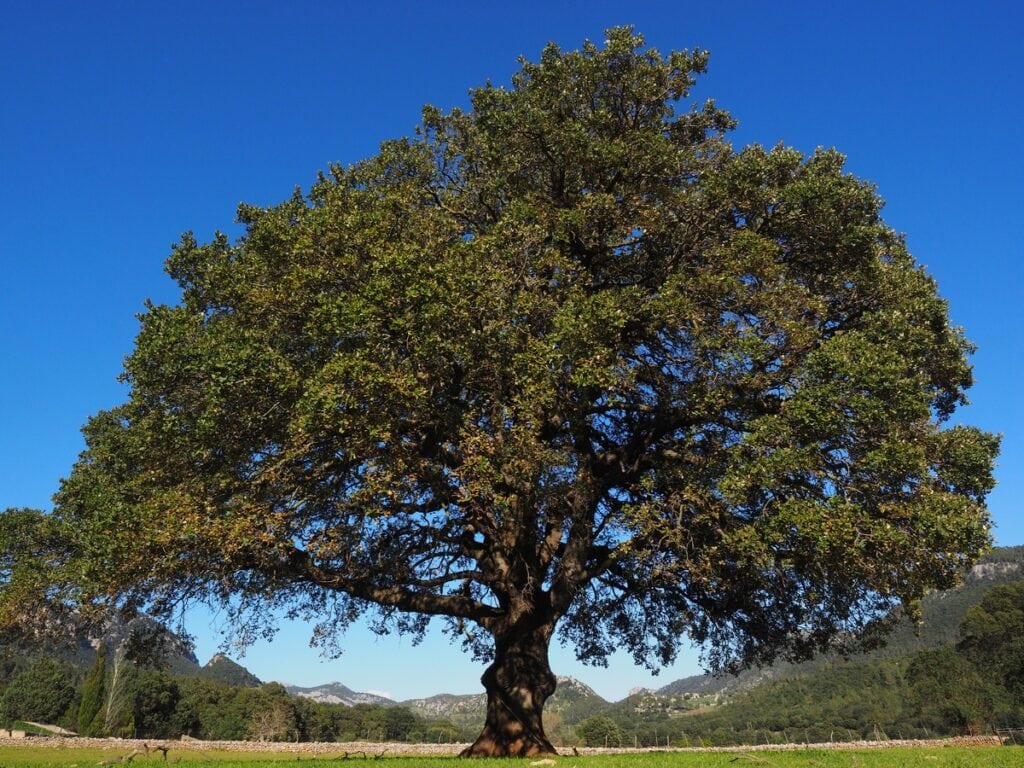
| Best Soil Type: | Well-drained soil, rich in humus (organic matter) |
| Soil pH: | Between 5.06 and 7.0 |
| Sunlight Exposure: | Four to six hours of direct sunlight every day |
| Watering Requirements: | Young oak trees need watering once every month |
| Optimum Growing Temperature: | Around 70°F (21°C) |
Blackberries and oak trees are a match made in heaven. They both prefer the same amount of sun and water. But there’s more to it than that.
Oak trees1 have mycorrhizal fungi in their roots, which helps the plant get nutrients from the soil and protect the plant against disease. You’ll have fewer problems with fungus on your berries if you grow blackberries near oak trees.
The tree will also provide shade against high temperatures during the summer months. It keeps your berry bushes cooler and they won’t suffer from heat stress or sunburned leaves. Dead oak leaves also add beneficial nutrients to the soil.
Blackberries are also beneficial to oak trees. They break up and loosen the soil, making oak tree roots spread. They also enhance moisture retention and aeration in the soil.
12. Beans
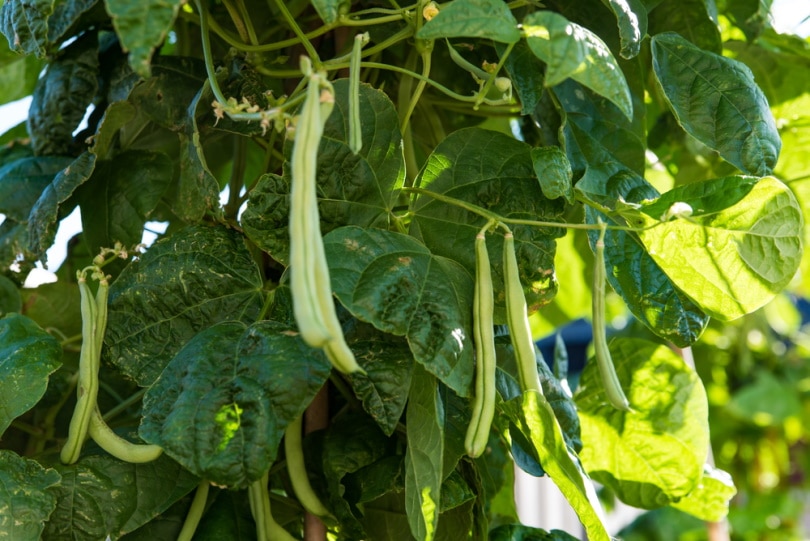
| Best Soil Type: | Well-draining, sandy and loamy soil |
| Soil pH: | 6.0 to 7.0 |
| Sunlight Exposure: | Full or medium sun |
| Watering Requirements: |
An inch of rain each week if planted in sandy soil. Beans planted in loamy soil need no watering.
|
| Optimum Growing Temperature: | Between 65°F and 85°F (18°C to 29°C) |
Legumes in general, and beans in specific fix nitrogen in the soil. The beans1 will also produce nitrogen-rich leaves. When these leaves die, you can use them as mulch around blackberry plants.
The best way to grow beans alongside blackberries is as a cover crop. Grow any bean type in rows. Let them produce and die. Then, plow them under. This way, they’ll add nutrients to the soil.
Worst Companion Plants for Blackberries
We’ve discussed the best companion plants for blackberries. Let’s now look at several plants you should keep away from your blackberry garden.

- Carrots: While these are an excellent addition to the vegetable garden, they don’t mix well with blackberries. The deep taproots use most of the nutrients blackberries need to grow well, thus stunting their growth and killing them.
- Raspberries: Blackberries and raspberries have similar growth habits. Both need similar nutrients from the soil. They compete for resources and can become stunted or damaged by the other’s presence. These two plants also share the same diseases. The best way to plant them is in separate containers far apart.
- Nightshade vegetables (eggplants, potatoes, and tomatoes)1 : These share the same pests as blackberries. The pests include caterpillars, aphids, armyworms, and hornworms. Nightshade vegetables can also spread diseases to blackberries. Grow these plants away from each other.
- Asparagus: It’s a perennial plant that needs full sun and rich soil to thrive. It’s also a heavy feeder and needs a lot of nutrients to thrive. It competes for the same nutrients and water that blackberries need, thus depriving your blackberries of essential nutrients. Since it will take over your entire garden, you need to plant it in its bed away from your blackberry plants.
Conclusion
So, there you have it! Companion plants are a great way to improve the health and growth of other plants, and blackberries are no exception. There’s no better way to ensure your blackberries thrive than to choose a companion crop that complements your soil. Go ahead and experiment with some of them in your garden!
Featured Image Credit: pixabay, Pexels
Contents



